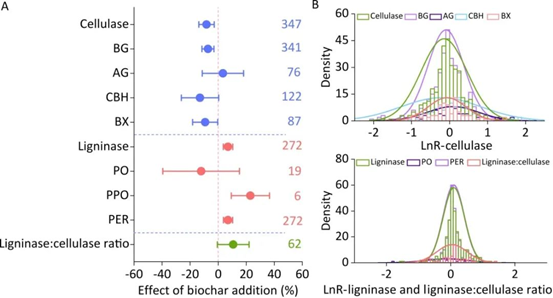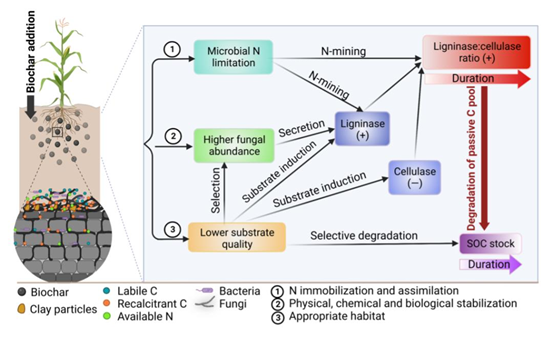(Nanhu News/Correspondent Feng Jiao) Recently, College of Resources and Environment of Huazhong Agricultural University published a paper named “Trade-offs in carbon-degrading enzyme activities limit long-term soil carbon sequestration with biochar addition” online on the journal Biological Reviews which focuses on ecology/agriculture and biological sciences. This paper clarifies the effects of biochar addition on soil C-degrading enzyme activities and the driving mechanism of long-term biochar addition affecting carbon sequestration.
Biochar is the product of biomass pyrolysis under high temperature and hypoxia and biochar addition has been regarded as an important way to increase soil C sequestration and slow down atmospheric CO2 concentration increase. In recent decades, biochar addition has been widely used, and it is expected to sequestrate 0.3–2.0 Pg CO2 from the atmosphere by 2050. However, although numerous studies have shown that biochar addition can promote soil C sequestration, it is still unknown how enzyme regulated decomposition processes affect long-term soil C sequestration.
Researchers collected 923 sets of soil C-degrading enzyme data from 130 articles across five continents worldwide through meta-analysis to analyze the effects of biochar addition on the decomposition process of soil organic C. In addition, 12194 pieces of information related to biochar addition test settings (time, materials, etc.), climate, soil, biological properties, etc. were collected to explore the mechanism of biochar addition affecting soil C sequestration. Studies showed that the biochar addition increased soil ligninase activity targeting complex phenolic macromolecules by 7.1%, but suppressed cellulase activity degrading simpler polysaccharides by 8.3%.

Figure 1. Effects of biochar addition on activity of cellulases, ligninases, and on the ligninase:cellulase ratio
The mixed effect model results showed that the trade-off between these two key enzymes (ligninase: cellulase ratio) was the most important factor in predicting the effect of soil C sequestration under biochar addition, and there was a significant negative correlation between them. In addition, the ratio of soil ligninase to cellulase significantly increased with the duration of biochar addition, resulting in a decrease in soil C sequestration effect with the duration of biochar addition (Figure 2).

Figure 2. Conceptual Paradigm of the mechanisms of enzyme-mediated soil C sequestration under biochar addition
The research results provide new evidence for the effect of biochar on long-term soil C sequestration from an enzymatic perspective, emphasizing that if temporal changes in the physiological acclimation of soil microorganisms are not considered, the estimation of soil C sequestration potential of biochar will be greatly improved.
Associate Researcher Feng Jiao of College of Resources and Environment of HAZU is the first author of the paper, and Professor Liu Yurong and Professor Chen Ji of Aarhus University in Denmark are the co-authors of the paper. Professor Robert L. Sinsabaugh of University of New Mexico, Professor Daryl L. Moorhead of University of Toledo, Professor Mathias Neumann Andersen of Aarhus University, Professor Pete Smith of University of Aberdeen, Professor Huang Qiaoyun of HZAU, and Master Yu Dailin also participated in the study. This research was supported by projects such as the National Natural Science Foundation of China and EU H2020 Marie Skłodowska-Curie Actions.
Translated by:Yang Sitong
Source:http://news.hzau.edu.cn/2023/0321/65918.shtml
